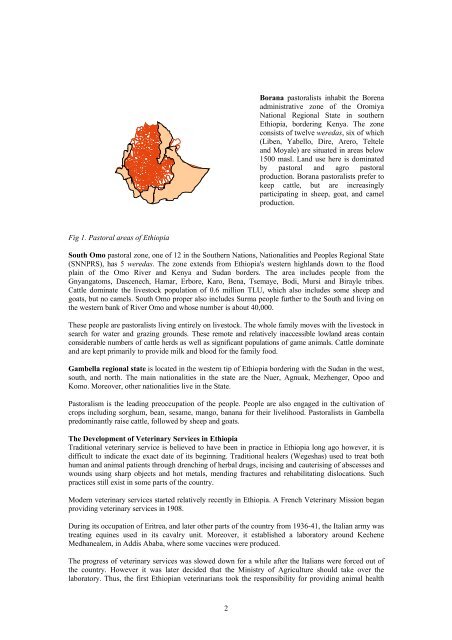Primary Animal Health Care in Ethiopia: The ... - Ethiopian Review
Primary Animal Health Care in Ethiopia: The ... - Ethiopian Review
Primary Animal Health Care in Ethiopia: The ... - Ethiopian Review
You also want an ePaper? Increase the reach of your titles
YUMPU automatically turns print PDFs into web optimized ePapers that Google loves.
Borana pastoralists <strong>in</strong>habit the Borenaadm<strong>in</strong>istrative zone of the OromiyaNational Regional State <strong>in</strong> southern<strong>Ethiopia</strong>, border<strong>in</strong>g Kenya. <strong>The</strong> zoneconsists of twelve weredas, six of which(Liben, Yabello, Dire, Arero, Telteleand Moyale) are situated <strong>in</strong> areas below1500 masl. Land use here is dom<strong>in</strong>atedby pastoral and agro pastoralproduction. Borana pastoralists prefer tokeep cattle, but are <strong>in</strong>creas<strong>in</strong>glyparticipat<strong>in</strong>g <strong>in</strong> sheep, goat, and camelproduction.Fig 1. Pastoral areas of <strong>Ethiopia</strong>South Omo pastoral zone, one of 12 <strong>in</strong> the Southern Nations, Nationalities and Peoples Regional State(SNNPRS), has 5 weredas. <strong>The</strong> zone extends from <strong>Ethiopia</strong>'s western highlands down to the floodpla<strong>in</strong> of the Omo River and Kenya and Sudan borders. <strong>The</strong> area <strong>in</strong>cludes people from theGnyangatoms, Dascenech, Hamar, Erbore, Karo, Bena, Tsemaye, Bodi, Mursi and Birayle tribes.Cattle dom<strong>in</strong>ate the livestock population of 0.6 million TLU, which also <strong>in</strong>cludes some sheep andgoats, but no camels. South Omo proper also <strong>in</strong>cludes Surma people further to the South and liv<strong>in</strong>g onthe western bank of River Omo and whose number is about 40,000.<strong>The</strong>se people are pastoralists liv<strong>in</strong>g entirely on livestock. <strong>The</strong> whole family moves with the livestock <strong>in</strong>search for water and graz<strong>in</strong>g grounds. <strong>The</strong>se remote and relatively <strong>in</strong>accessible lowland areas conta<strong>in</strong>considerable numbers of cattle herds as well as significant populations of game animals. Cattle dom<strong>in</strong>ateand are kept primarily to provide milk and blood for the family food.Gambella regional state is located <strong>in</strong> the western tip of <strong>Ethiopia</strong> border<strong>in</strong>g with the Sudan <strong>in</strong> the west,south, and north. <strong>The</strong> ma<strong>in</strong> nationalities <strong>in</strong> the state are the Nuer, Agnuak, Mezhenger, Opoo andKomo. Moreover, other nationalities live <strong>in</strong> the State.Pastoralism is the lead<strong>in</strong>g preoccupation of the people. People are also engaged <strong>in</strong> the cultivation ofcrops <strong>in</strong>clud<strong>in</strong>g sorghum, bean, sesame, mango, banana for their livelihood. Pastoralists <strong>in</strong> Gambellapredom<strong>in</strong>antly raise cattle, followed by sheep and goats.<strong>The</strong> Development of Veter<strong>in</strong>ary Services <strong>in</strong> <strong>Ethiopia</strong>Traditional veter<strong>in</strong>ary service is believed to have been <strong>in</strong> practice <strong>in</strong> <strong>Ethiopia</strong> long ago however, it isdifficult to <strong>in</strong>dicate the exact date of its beg<strong>in</strong>n<strong>in</strong>g. Traditional healers (Wegeshas) used to treat bothhuman and animal patients through drench<strong>in</strong>g of herbal drugs, <strong>in</strong>cis<strong>in</strong>g and cauteris<strong>in</strong>g of abscesses andwounds us<strong>in</strong>g sharp objects and hot metals, mend<strong>in</strong>g fractures and rehabilitat<strong>in</strong>g dislocations. Suchpractices still exist <strong>in</strong> some parts of the country.Modern veter<strong>in</strong>ary services started relatively recently <strong>in</strong> <strong>Ethiopia</strong>. A French Veter<strong>in</strong>ary Mission beganprovid<strong>in</strong>g veter<strong>in</strong>ary services <strong>in</strong> 1908.Dur<strong>in</strong>g its occupation of Eritrea, and later other parts of the country from 1936-41, the Italian army wastreat<strong>in</strong>g equ<strong>in</strong>es used <strong>in</strong> its cavalry unit. Moreover, it established a laboratory around KecheneMedhanealem, <strong>in</strong> Addis Ababa, where some vacc<strong>in</strong>es were produced.<strong>The</strong> progress of veter<strong>in</strong>ary services was slowed down for a while after the Italians were forced out ofthe country. However it was later decided that the M<strong>in</strong>istry of Agriculture should take over thelaboratory. Thus, the first <strong>Ethiopia</strong>n veter<strong>in</strong>arians took the responsibility for provid<strong>in</strong>g animal health2




![to read the full report [pdf, Amharic] - Ethiopian Review](https://img.yumpu.com/52737829/1/190x245/to-read-the-full-report-pdf-amharic-ethiopian-review.jpg?quality=85)











